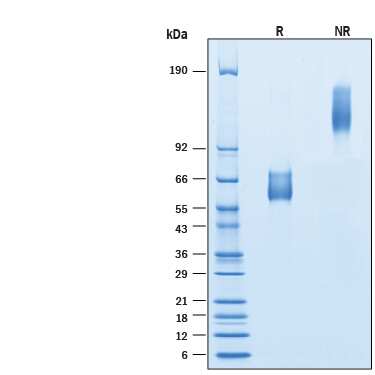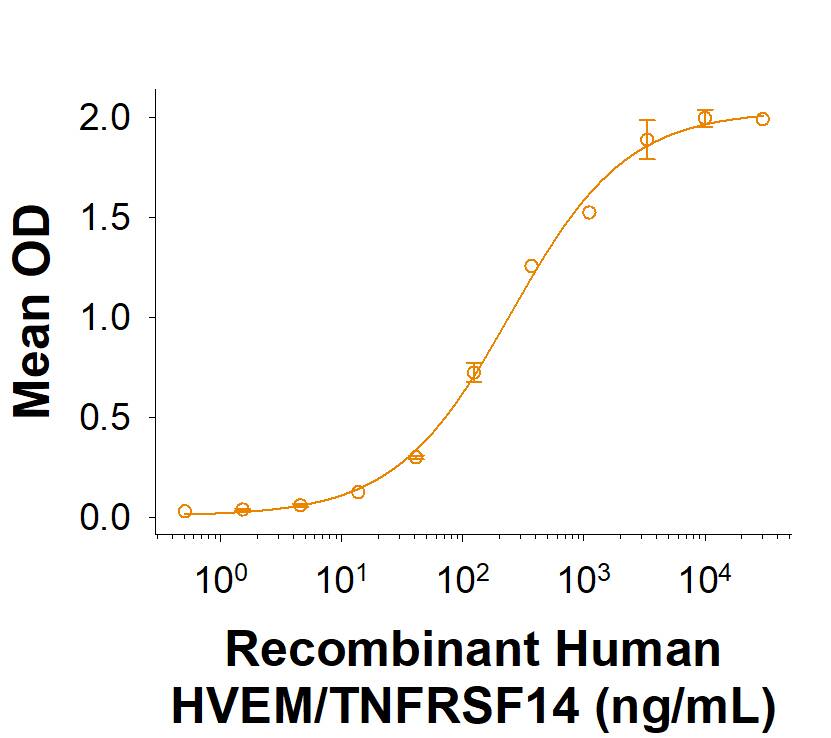Recombinant Human HVEM/TNFRSF14 Fc Chimera Protein, CF
R&D Systems, part of Bio-Techne | Catalog # 11177-HV

Key Product Details
Source
HEK293
Accession #
Structure / Form
Disulfide-linked homodimer
Conjugate
Unconjugated
Applications
Bioactivity
Product Specifications
Source
Human embryonic kidney cell, HEK293-derived human HVEM/TNFRSF14 protein
| Human HVEM/TNFRSF14 (Pro37-Val202) Accession # Q92956.3 |
IEGRMD | Human IgG1 (Pro100-Lys330) |
| N-terminus | C-terminus |
Purity
>95%, by SDS-PAGE visualized with Silver Staining and quantitative densitometry by Coomassie® Blue Staining.
Endotoxin Level
<0.10 EU per 1 μg of the protein by the LAL method.
N-terminal Sequence Analysis
Pro37
Predicted Molecular Mass
44 kDa
SDS-PAGE
55-75 kDa, under reducing conditions.
Activity
Measured by its binding ability in a functional ELISA.
When Recombinant Human BTLA (Catalog # 9235-BT) is immobilized at 1 µg/mL (100 µL/well), Recombinant Human HVEM/TNFRSF14 Fc Chimera (Catalog # 11177-HV) binds with an ED50 of 50.0-600 ng/mL.
When Recombinant Human BTLA (Catalog # 9235-BT) is immobilized at 1 µg/mL (100 µL/well), Recombinant Human HVEM/TNFRSF14 Fc Chimera (Catalog # 11177-HV) binds with an ED50 of 50.0-600 ng/mL.
Scientific Data Images for Recombinant Human HVEM/TNFRSF14 Fc Chimera Protein, CF
Recombinant Human HVEM/TNFRSF14 Fc Chimera Protein Binding Activity.
When Recombinant Human BTLA (9235-BT) is immobilized at 1 µg/mL (100 µL/well), Recombinant Human HVEM/TNFRSF14 Fc Chimera Protein (Catalog # 11177-HV) binds with an ED50 of 50.0-600 ng/mL.Recombinant Human HVEM/TNFRSF14 Fc Chimera Protein SDS-PAGE.
2 μg/lane of Recombinant Human HVEM/TNFRSF14 Fc Chimera Protein (Catalog # 11177-HV) was resolved with SDS-PAGE under reducing (R) and non-reducing (NR) conditions and visualized by Coomassie® Blue staining, showing bands at 55-75 kDa and 110-150 kDa, respectively.Formulation, Preparation and Storage
11177-HV
| Formulation | Lyophilized from a 0.2 μm filtered solution in PBS with Trehalose. |
| Reconstitution | Reconstitute at 500 μg/mL in PBS. |
| Shipping | The product is shipped at ambient temperature. Upon receipt, store it immediately at the temperature recommended below. |
| Stability & Storage | Use a manual defrost freezer and avoid repeated freeze-thaw cycles.
|
Background: HVEM/TNFRSF14
References
- Steinberg, M.W. et al. (2011) Immunological reviews 244:169.
- Liu, W. et al. (2021) J Exp Med. 218:e20211112).
- Demerlé C. et al. (2021) Front Oncol. 2021 11:682007.
- del Rio, M.L. et al. (2010) J. Leukoc. Biol. 87:223.
- Heo, S.K. et al. (2006) J. Leukoc. Biol. 79:330.
- Cai, G. et al. (2008) Nat. Immunol. 9:176.
- Gonzalez, L.C. et al. (2005) Proc. Natl. Acad Sci. USA 102:1116.
- Tao, R. et al. (2008) J. Immunol. 180:6649.
- Steinberg, M.W. et al. (2013) PLoS One 8:e77992.
- Shui, J.W. et al. (2012) Nature 488:222.
- Aubert, N. et al. (2021) Cancers (Basel) 13:3009.
- Boice, M. et al. (2016) Cell. 167:405.
Long Name
Herpesvirus Entry Mediator
Alternate Names
ATAR, CD270, LIGHTR, TNFRSF14
Gene Symbol
TNFRSF14
UniProt
Additional HVEM/TNFRSF14 Products
Product Documents for Recombinant Human HVEM/TNFRSF14 Fc Chimera Protein, CF
Product Specific Notices for Recombinant Human HVEM/TNFRSF14 Fc Chimera Protein, CF
For research use only
